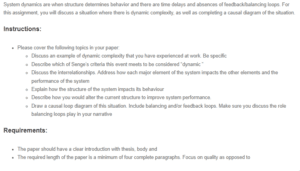Discussion – Dynamic Complexity
In systems thinking, dynamic complexity refers to a component of a complex system that behaviorally influences parts of a system. External and internal changes trigger the complex system to change. A dynamic complexity occurs once the system’s components are stressed enough to produce unexpected outcomes. Since an action has a set of dramatically different outcomes in the short run and the long run in an organizational setting, it is incumbent upon managers to adapt and apply necessary measures to curb adverse changes. An analysis of Senge’s position on dynamic complexity reveals the need to recognize the underlying and hidden causes of a problem to understand its consequences.
Dynamic Complexity Experience
At Barnabas Professional School, where I worked as an operations manager, the dynamic complexity I encountered was noise from coworkers conversing with one another and movements around the office. As a result, I had to use noise-cancelling headphones to focus on my work. This resulted in a communication disruption with my team, especially when we needed to converse about how we could approach specific tasks.
Senge’s Criteria for Dynamic Complexity Met by This Experience
The situation explained above meets one of the criteria for determining dynamic complexities. In this case, an action has one set of consequences locally and a completely different set of consequences in another part of the system (Senge, 2006). As per the case above, putting on noise-canceling headphones inhibits the impact of office noise and movements, thereby facilitating focus. On the other negative side, the noise-canceling headphones prevent me from communicating effectively with my team members, thus affecting work outcomes.
Interrelationships Between Major Elements of the System
According to Behl and Ferreira (2014), interrelationships apply in dynamic complexities because the occurrences that preceded the dynamic problem do not align with a linear causal-effect chain. In this specific case, for instance, there are no obvious underlying reasons for increased noise in the office. First, the lack of proper office arrangements keeps colleagues moving from one point to another, leading to more noise. Another potential cause for noise around the office area is a lack of reminders to remind office users to be mindful of their colleagues while conversing. There is no linear causal effect between elements in a dynamic complexity. Instead, inter-relationships among different elements of the system lead to the undesired outcome.
How the Structure of the System Impacts Its Behavior
One of the components of a structure that impacts the behavior of the entire structure is team organization. In the complex dynamic case explained above, the workplace is designed to facilitate teamwork. Since team structures produce a much freer workplace, it was inevitable that noise would come into play (Ahmada & Fakhr, 2022). Also, the divisional structure of work at the workplace means employees operate in separate groups. The divisional structure centralizes operations, forcing employees to keep consulting among themselves and with the manager, resulting in noise.
Altering the Structure to Improve Performance
According to Lunenburg (2011), organizations are in continual learning loops. The best way to curb disruptions exhibited by the described above is by assigning each division its operational equipment. That means there will be no unnecessary movements around the office since every employee will access their work tools from the desk. Alternatively, the organization should consider having an extra office for the team. Subsequently, the number of people working from the same space will be cut off, reducing disruptions and noise.
Causal Loop Diagram
The causal loop diagram above has both feedback and balancing loops. Balancing loops are the links between different elements in a system that try to return a deviated variable to the initial state. In the diagram above, reduced office interaction and putting on headphones aim to reduce noise at the office.
Conclusion
Curbing office noise is fundamentally a problem of complexity. Insights into the causes and cures of distractive noise at the office require considering the interrelationships of different elements. Once the interrelationships underlying the problem emerge, insights into avoiding escalation can be implemented. Dealing with dynamic complexity requires investigating the whole process rather than looking at snapshots.
References
Ahmada, H. A., & Fakhr, R. (2022). Relationship between organizational structure and employee behavior. Journal of Positive School Psychology, 6(8), 1959-1963.
Behl, D. V., & Ferreira, S. (2014). Systems thinking: An analysis of key factors and relationships. Procedia Computer Science, 36, 104-109.
Lunenburg, F. C. (2011). Systems thinking and the learning organization: The path to school improvement. Schooling, 2(1), 1-6.
Senge, P. M. (2006). The fifth discipline: The art and practice of the learning organization. Broadway Business.
ORDER A PLAGIARISM-FREE PAPER HERE
We’ll write everything from scratch
Question

Discussion – Dynamic Complexity
System dynamics are when structure determines behavior and there are time delays and absences of feedback/balancing loops. For this assignment, you will discuss a situation where there is dynamic complexity, as well as completing a causal diagram of the situation.
Instructions:
- Please cover the following topics in your paper:
- Discuss an example of dynamic complexity that you have experienced at work. Be specific
- Describe which of Senge’s criteria this event meets to be considered “dynamic ”
- Discuss the interrelationships. Address how each major element of the system impacts the other elements and the performance of the system
- Explain how the structure of the system impacts its behaviour
- Describe how you would alter the current structure to improve system performance.
- Draw a causal loop diagram of this situation. Include balancing and/or feedback loops. Make sure you discuss the role balancing loops play in your narrative
Requirements:
- The paper should have a clear introduction with thesis, body and
- The required length of the paper is a minimum of four complete paragraphs. Focus on quality as opposed to

